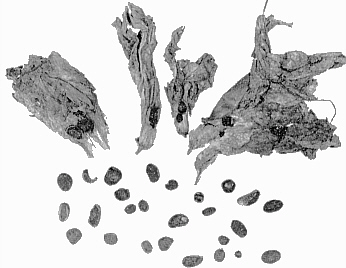QBARS - v27n4 Occurrence of Azalea Petal Blight in Connecticut
Occurrence of Azalea Petal Blight in Connecticut
R. G. Linderman
Reprinted from Vol. 56, No. 12 - Plant Disease Reporter - December 1972
Research Plant Pathologist, Plant Genetics and Germplasm Institute
U. S. Department of Agriculture, Agricultural Research Service
Agricultural Research Center, Beltsville, Maryland
Abstract. Azalea petal blight ( Ovulinia azaleae) is reported in Connecticut. This is the most northern report, but the disease occurred only on late blooming varieties.

|
|
|
FIG. 54. Sclerotia of the azalea petal blight fungus,
Ovulinia azaleae Weiss, separated from or still in dried flowers of cv. 'Louise Gable'. Photo by R. G. Linderman |
In August 1972 a sample of azalea flowers containing sclerotia of the petal blight fungus, Ovulinia azaleae, Weiss (Fig. 54), was received from a private gardener in New Canaan, Connecticut. Ever since 1940, when azalea petal blight was described by Weiss and Smith (3), it has been considered to be geographically limited to the warmer Southern States, except in the confines of northern greenhouses (1).
More recently, however, the disease was detected in several gardens in central New Jersey (2), which, so far as I know, was then the most northern report of its occurrence. I also received a petal blight sample from Rutherford, New Jersey, and the disease has been observed in southeastern Pennsylvania (A. E. Kehr, personal communication). The sample from New Canaan, Connecticut, however, establishes the occurrence of O . azaleae even farther north than New Jersey. This report supports the thesis that the range of O. azaleae is not limited by unfavorable conditions out-of-doors in the North (1), but rather that it can survive northern conditions once introduced. As the owner of the garden in New Canaan pointed out, however, the petal blight disease only occurred on the late-blooming varieties such as Louise Gable. It was first observed in the spring of 1970, again in 1971, and was quite evident in 1972 on all of his late blooming varieties that bloomed from May 20 through June. It is possible that the pathogen has been introduced into northern areas before this time and survived, but it did not increase its inoculum because of the limitation of environmental factors on apothecial formation, ascosporic infection of flowers, and subsequent formation of sclerotic to carry it over until the following spring.
LITERATURE CITED
- NELSON, PAUL E., C. E. WILLIAMSON, and W.D.McCLELLAN, 1956, Ovulinia flower spot of azalea found on Long Island, Plant Disease Reptr., 40:1115.
- PETERSON, J. L., and S. H. DAVIS, Jr., 1971, A new look at azalea petal blight control, Quart. Bull. of Am. Rhododendron Soc., 25(3): 170-171.
- WEISS, F., and F. F. SMITH, 1940, A flower-spot disease of cultivated azaleas, U.S. Dept. of Agr. Circ., 556:1-2s.
